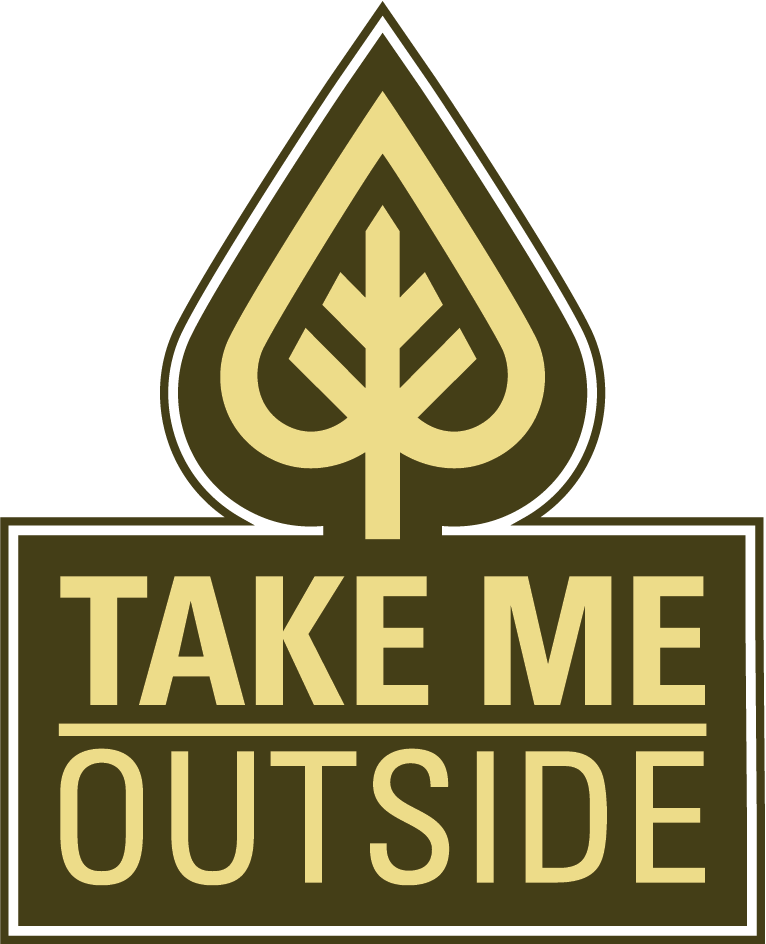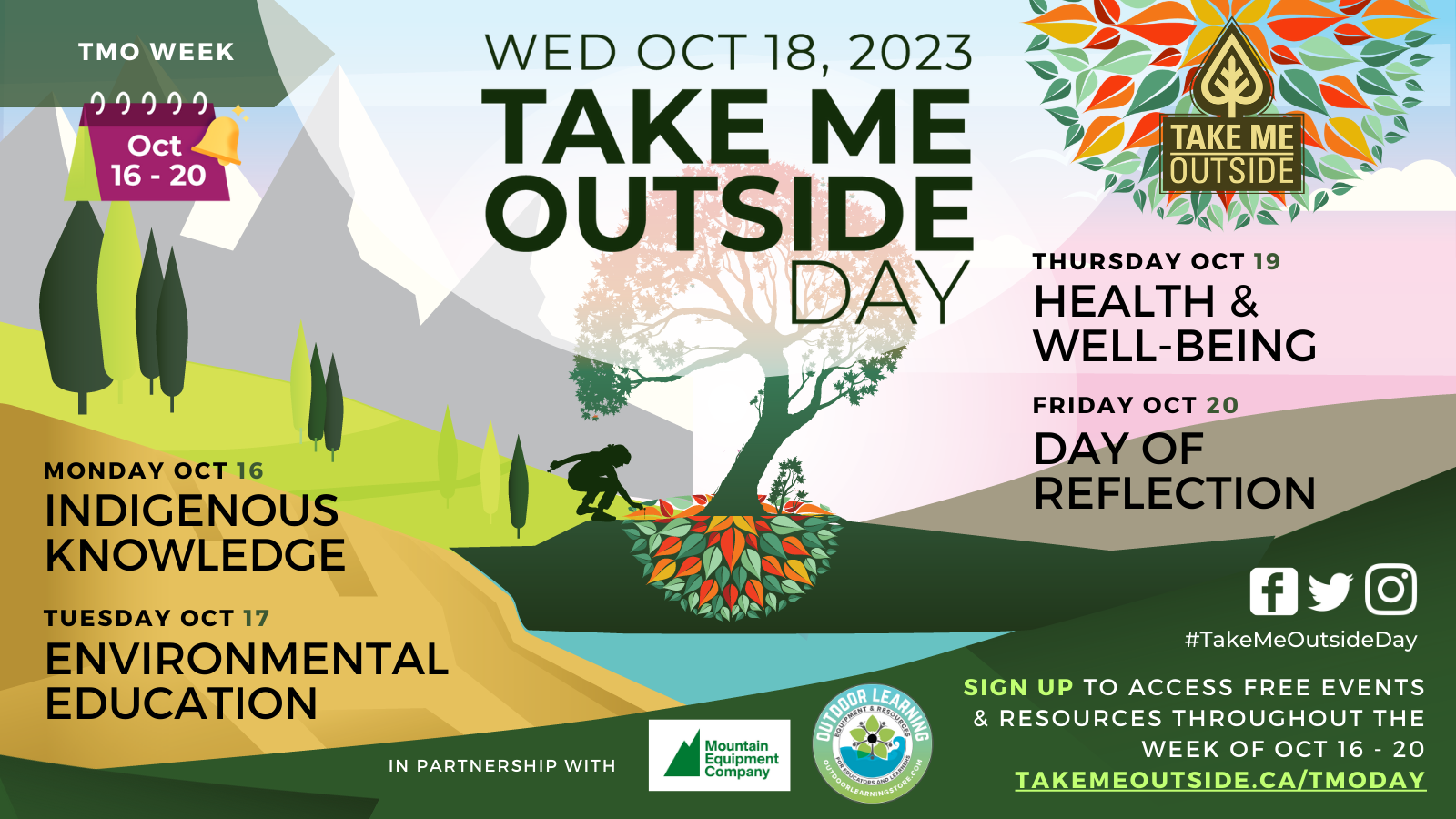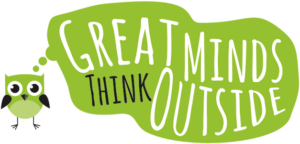TMO Day 2023: Indigenous Knowledge & Perspectives
Enjoy these activities for Take Me Outside Day and week, or any other day of the year! Please feel free to share widely, and reach out if you know of an activity or resource that should be added to the list. Then head outside!
Monday October 16th – Theme: Indigenous Knowledge
Getting to Know the Land
Grade: 4-12
Subjects: Social Studies, Geography, Language, Health
Teaching Strategies: Movement based learning, Critical thinking, Indigenous perspectives
Connect with a local Friendship Centre, First Nations Band Office, Métis Community Council, or Inuit group to establish a friendship and connection with an Elder or indigenous knowledge keeper who may be able to share a written, recorded, or in-person version of their local creation story. After the creation story has been shared with students, engage in enriching conversations about how students connect with their local lands, and reflect on how many indigenous peoples have always lived WITH the land versus off the land, and continue to do so today. Ideally with this new indigenous mentor and friend, take students to a forest, trail, or greenspace and have them locate different natural items, encouraging them to reflect on how they or their ancestors connect with this natural being. Continue learning with a sharing circle or the ceremonial choosing of the knowledge keepers choice. View this resource on Getting to Know the Land from PHE Canada here!
Patterns in Relationship: Ethnobotany
Grade: 4-7
Subjects: Health, Social Studies, Geography, Language
Teaching Strategies: Critical thinking, Indigenous perspectives and knowledge 
This activity can be used in conjunction with Patterns, Plants and Playgrounds also from Evergreen. These activities all focus on the relationship between people and plants to engage students in learning about the native plants of the coastal region of British Columbia and the traditions associated with local First Nations cultures. Get your kids excited with these activities that range from making a medicine wheel to identifying plants in Halkomelem, a West Coast First Nations language. It was written by educator Illene Pevec and piloted at Grandview/U’uqinak’uuh Elementary School in Vancouver, BC. Check out this learning module from Evergreen on Ethnobotany here!
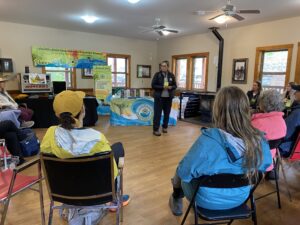
Faye O’Neil, Indigenous Education Coordinator for SD 5, welcomes the group in Revelstoke, BC: Territory of the Sinixt, and an area also known over different historical times to the Ktunaxa, Secwepmemc, and Okanagan Sylix people.
Ocean Wise: Átl’ḵa7tsem/Txwnéwu7ts/ Howe Sound Education Kit
Grade: K-12
Subjects: Social Studies, Science, Language, Art
Teaching Strategies: Critical thinking, Indigenous perspectives, Outdoor Learning, Citizen Science
This Átl’ḵa7tsem/Txwnéwu7ts/ Howe Sound Education Kit from Ocean Wise provides incredibly detailed and organized lessons, complete with an educator guidebook and corresponding student workbook. Átl’ḵa7tsem/Txwnéwu7ts/ Howe Sound is a coastal fjord ecosystem in the Salish Sea. It is a vital area to local First Nation communities, providing natural resources that allowed Indigenous peoples to thrive for generations before colonization. Following colonization and years of destructive human activity, such as industrial and coastal development, efforts are currently underway by government, industry groups, and local communities to transition the Sound’s marine ecosystem from crisis to recovery. Indigenous communities, in particular, are working hard to restore life and traditional practices for generations to come. Using Átl’ḵa7tsem/ Txwnéwu7ts/ Howe Sound as a case study, students can recognize how ecosystems, species, human impact, and climate change are interconnected. This work is essential for students to make informed decisions as the future stewards of our planet.
Facing Colonization in our Work with the Land & Building our Understanding of Indigenous Perspectives
Grade: K-12 (educator education for all grades of teachers)
Subjects: Social Studies, Geography, Language, Health
Teaching Strategies: Inclusion, Culturally sensitive and conscious ed, Indigenous perspectives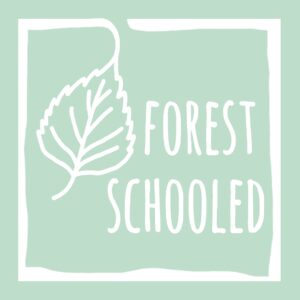
Forest Schooled educators, Landere Naisbitt & Caylin Gans, reflect on the importance of acknowledging Indigenous peoples’ presences, histories, and worldviews, which encompass a deep relationship to the land, and bridge the difficult but necessary conversation that if we aren’t inclusive of these worldviews and cultures, we are perpetuating colonialism and systems of oppression even within seemingly innocent nature-based, outdoor education programs.
This living document provides educators with terms, tips for starting practices for acknowledging indigenous presences, histories and perspectives and how they facilitate learning sessions with sensitive and inclusive practices.
Click here for this important document: Facing Colonization in our Work with the Land & Building our Understanding of Indigenous Perspectives.
Grade: All Grades
Subjects: ANY
Teaching Strategies: Critical thinking, Place based learning, Collaborative learning
Choose an object to facilitate the listening circle, such as a small stone or a pine cone. The object is passed around from person to person, allowing only the person holding the object to speak. This enables all those present to be heard, especially those who may be shy. Sitting in silence for a few moments before the object is passed is also permitted. Consensus can focus on the object to move along, to assure that the “long winded” don’t dominate the discussion.
Please note: This activity is inspired by a “talking circle” which refers to a spiritual practice used in many Indigenous nations involving specific ceremonies, invitations to ancestors, and regional differences between nations. With the guidance of an elder or knowledge keeper, a talking stick circle could be used, in replacement of this less formal Listening Circle exercise.

Selkirk First Nation (Pelly Crossing, Yukon) Elders holding a circle for the youth to discuss respect and community, Fall 2015 Minto Culture Camp
Create a Land Acknowledgment
Grade: All Grades
Subjects: English/Language arts, Geography, Religion, Social Studies, History
Teaching Strategies: Place based learning, collaborative learning, critical thinking
This activity can be an individual task or a group/collaborative activity. Students can create their own land acknowledgment for their personal classroom. Encourage students to discuss and research Indigenous groups of Canada and their historical residences on this land. For elementary students, this may take the form of a poem or song. Give students time to reflect on their own personal relationship to the land.
For secondary students, consider asking questions like: What should a land acknowledgment say? Who should a land acknowledgment be for? What is the purpose of acknowledging the land?
Once students create their own land acknowledgment, allow them to write down pieces of their own onto a collaborative class document (on the chalkboard, chart paper, google docs, etc). Co-constructing a land acknowledgment can be a powerful tool in continuing to learn more about Indigenous groups and their importance to Canadian culture.
For more information, check out native-land.ca
Tuning into your Senses
Authored by Carolynne Crawley
Grades: All Grades
Subjects: Interdisciplinary
Teaching Strategy: Reflective Practice, Metacognition, Outdoor Learning
This activity should be guided while outdoors preferably in a garden, park, ravine, or any other
“green space.” It creates an opportunity for students to be in the present moment and tuned
into their surroundings through their senses. Invite students to get comfortable preferably
sitting. They may close their eyes if they feel comfortable to do so. Suggest they take a few
slow deep breaths. Then guide them slowly through each of their senses while giving them 30
seconds to notice what they are experiencing before moving onto the next sense. For example
asking the students “Bring your attention to your sense of smell. Perhaps take some long deep
breaths to notice any scents in the air.” “Notice the sounds surrounding you in this moment.
Notice the sounds closest to you and farthest from you” End the guided sensory experience
with their sense of sight by inviting them to open their eyes and notice their surrounding. Create an opportunity for sharing.
Notice Who is in Motion
Authored by Carolynne Crawley
Grades: All Grades
Subjects: Geography, Science, Health
Teaching Strategy: Outdoor Learning, Reflective Practices, Active learning
This activity should be guided while outdoors preferably in a garden, park, ravine, or any other
“green space.” Invite the students to move very slowly by setting the pace for them. Suggest
they move along a trail, walk way, or move around in the area and notice who is moving on the
land. Perhaps doing this in silence and another time not in silence while moving quickly. That
way students can learn that moving slowly in silence creates opportunity to notice more and
lessen the level of disturbance upon wildlife. Engage in this activity for five to twenty minutes.
Create an opportunity for students to share what they noticed as a group or in partners.
Memory a.k.a Kim’s Game
Authored by Carolynne Crawley
Grades: Grades K-6
Subjects: All Subjects
Teaching Strategy: Active learning, Reflective Learning
Find eight to twelve objects from nature such as feathers, leaves, stones, shells, seeds, etc.
Place them onto a table or floor with a cloth covering the objects. Invite the students to gather
around the table and remove the cloth to show them the items. The objects are to remain on
the table/floor. Give students up to 30 seconds to memorize the objects then cover them up.
Ask the students questions for memory recall such as How many objects are on the table?
Name the objects. Once a student names an object ask students specific questions to see if
they can recall any details about that object such as the shape, colour(s), and size. Once
students can no longer answer any of the questions about any of the objects remove the cloth
again for up to 15 seconds to create opportunity for students to retain more detailed information.
Once again ask students questions after covering up the objects. This can be adapted for any
subject. Instead of objects it could be words, numbers, or shapes that are used for memory
recall.
